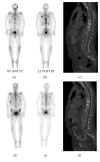Radium-223 Therapy for Patients with Metastatic Castrate-Resistant Prostate Cancer: An Update on Literature with Case Presentation
- PMID: 27774318
- PMCID: PMC5059539
- DOI: 10.1155/2016/2568031
Radium-223 Therapy for Patients with Metastatic Castrate-Resistant Prostate Cancer: An Update on Literature with Case Presentation
Abstract
Background and Purpose. Radium-223 dichloride (Xofigo®, Bayer HealthCare Pharmaceuticals Inc.) is the first α-particle emitter therapeutic agent approved by the FDA, with benefits in overall survival and delay in symptomatic skeletal event for patients with metastatic castrate-resistant prostate cancer (CRPC). Recent post hoc analyses of the phase III ALSYMPCA trial support the previously established safety profile as well as therapeutic effect and clinical outcome of Radium-223. Currently, Radium-223 is approved as a single agent therapy for metastatic CRPC. Clinical trials are currently investigating Radium-223 in additional clinical settings such as earlier asymptomatic disease and in combination with other agents including hormonal therapeutic agents and immunotherapeutic as well as chemotherapeutic agents. Trials are also ongoing in patients with other primary cancers such as breast cancer, thyroid cancer, and renal cancer metastatic to bone. In this article, the physics and radiobiology, as well as a literature update on the use of Radium-223, are provided along with case presentations, aiming at a better appreciation of research data as well as the assimilation of research data into clinical practice.
Figures



References
-
- Howlader N., Noone A. M., Krapcho M., et al. SEER Cancer Statistics Review, 1975–2013. Bethesda, Md, USA: National Cancer Institute; based on November 2015 SEER data submission, posted to the SEER web site, 2016.
Publication types
LinkOut - more resources
Full Text Sources
Other Literature Sources

